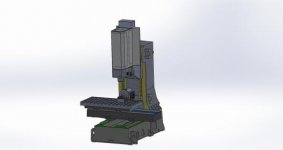rcoope
Stainless
- Joined
- Sep 25, 2010
- Location
- Vancouver Canada
We have finally been getting to grips with five axis simulations using a custom machine model I build of our VM-3 and TRT-160. The main challenge was figuring out how to position the workpiece properly so considerable YouTube watching was performed on company time. That, and looking at Mastercam 2021 and 2022 itself, led to the realization that THERE ARE TWO DIFFERENT SIMULATION PROGRAMS AVAILABLE!!?! Now it turns out this matters as the older one just takes your stack of workpiece and fixture and finds whatever is the bottom of that and mates it with your model origin. In my case I currently have the origin along the B-axis so it's 0.75" above the C-axis platen surface. You can get around this by creating a fake fixture that's 0.75" shorter than the real one, or I could redo the simulator model so the origin is in the C-axis platen plane. Meanwhile the newer simulator puts the workpiece WCS origin at the simulator origin, but, crucially, then allows you to offset it in X, Y and Z, so you can get it into the actual correct position.
Of course the two simulators also have other minor differences, like the old one seems to have a better optional stop, but the newer one is used to actually edit a new simulator which you can't in the old one. So other than recording this information for posterity, I wanted to ask if anyone around here knows why the hell they would be running two simulator environments and have them available at the same time? I know other programs have a little bit of this eg, Solidworks has a couple of rendering engines, but that's no where near this egregiously complicated for general use. I supposed I could ask this in the E-mastercam forums but this place is more fun, and Marcus posts here.
Check out my VM-3, TRT-160 simulator model. I'm proud of it.

Of course the two simulators also have other minor differences, like the old one seems to have a better optional stop, but the newer one is used to actually edit a new simulator which you can't in the old one. So other than recording this information for posterity, I wanted to ask if anyone around here knows why the hell they would be running two simulator environments and have them available at the same time? I know other programs have a little bit of this eg, Solidworks has a couple of rendering engines, but that's no where near this egregiously complicated for general use. I supposed I could ask this in the E-mastercam forums but this place is more fun, and Marcus posts here.
Check out my VM-3, TRT-160 simulator model. I'm proud of it.




